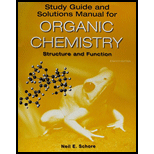
(a)
Interpretation: The predominant elimination mechanism when concentration of NaOCH2CH3is 0.01 M needs to be determined.
Concept Introduction: The elimination reaction of an
The rate of E1 mechanism depends only on the concentration of haloalkane and it is represented as follows:
Similarly, rate of E2 mechanism depends on both concentration of haloalkane and base thus,
(b)
Interpretation: The predominant elimination mechanism when concentration of NaOCH2CH3is 1.0 M needs to be determined.
Concept Introduction: The elimination reaction of an alkyl halide with nucleophile results in the formation of corresponding alkenes. There are two mechanisms that is E1 and E2. The E1 reaction is 2-step reaction and results in the formation of a carbocation first. The step 2 involves the formation of alkene after removal of the alpha hydrogen present in the carbocation. In the E2 mechanism, direct attack of the nucleophile and removal of leaving group takes place on the hydrogen atom which is at alpha position to the leaving group.
The rate of E1 mechanism depends only on the concentration of haloalkane and it is represented as follows:
Similarly, rate of E2 mechanism depends on both concentration of haloalkane and base thus,
(c)
Interpretation: The concentration of base at which 50% of the starting material reacts following E1 mechanism and 50% by E2 mechanism needs to be determined.
Concept Introduction: The elimination reaction of an alkyl halide with nucleophile results in the formation of corresponding alkenes. There are two mechanisms that is E1 and E2. The E1 reaction is 2-step reaction and results in the formation of a carbocation first. The step 2 involves the formation of alkene after removal of the alpha hydrogen present in the carbocation. In the E2 mechanism, direct attack of the nucleophile and removal of leaving group takes place on the hydrogen atom which is at alpha position to the leaving group.
The rate of E1 mechanism depends only on the concentration of haloalkane and it is represented as follows:
Similarly, rate of E2 mechanism depends on both concentration of haloalkane and base thus,
Want to see the full answer?
Check out a sample textbook solution
Chapter 7 Solutions
EBK STUDY GUIDE/SOLUTIONS MANUAL FOR OR
- Draw the curved arrow mechanism for this reaction starting with 2-propanol in sulfuric acid. Show all nonzero formal charges and all nonbonded electrons in each step. Species not involved in a particular step do not need to be included in that step, and resonance forms do not need to be shown. Note that the alcohol is in much higher concentration than H₂O in this reaction. Harrow_forwardProvide reactions showing the following conversions: * see imagearrow_forward. Draw structures corresponding to each of the following names or Provide IUPAC names for each of the ollowing structures [for 4 ONLY]. A. 2-propylpentanoic acid. B. m-chlorobenzoic acid. D. C. O O HOC(CH2)3COH glutaricadd OH OH H3C CH3 C=C H COOH salicylicadd tiglicadd CH₂C=N Joe Marrow_forward
- . Provide structure(s) for the starting material(s), reagent(s) or the major organic product(s) of each of the ollowing reactions or sequences of reactions. Show all relevant stereochemistry [five only] A. O B. OET CH3 1. LIAIH, ether 2 H₂O O (CH3)2CH-C-CI + 0 0 ether (CH3)2CH-C-O-C-CH3 CH3 C. 0 OH HO CH3 ° Clarrow_forwardHow would you prepare each of the following compounds using either an acetoacetic ester synthesis or a alonic ester synthesis? Show all intermediate structures and all reagents.[Three only] A. B. COOH OH C. D. 0 H2C CHCH2CH2CCH3arrow_forwardFats and greases have mostly aliphatic regions which are hydrophobic. Provide a schematic of howsoaps/detergents remove fats and grease from the soiled material. * see imagearrow_forward
- What chemical has the common name "lye"? Pick one of the 3 esters and show the hydrolysis mechanism to make a carboxylic acid. The organic “R” should be used to limit the redrawing time of the entire molecule. * see imagearrow_forwardProvide the products for each reaction. There are two and they are not related. *see imagearrow_forwardd. a phenylal Give the major organic product(s) of each of the following reactions or sequences of reactions. Show all levant stereochemistry. [three only] 0 A. B. CH3 Bra CH3COOH OH 1. Br₂, PBrz 2 H₂O 12arrow_forward
- 2arrow_forwardShow how the following conversions might be accomplished. Show all reagents and all intermediate ructures. More than one step may be required [2 ONLY]: A. B. ° C. OH 0 OH 0arrow_forwardA 20.3 mL sample of 0.263 M triethylamine, (C2H5)3N, is titrated with 0.252 M hydrochloric acid. (1) At the titration midpoint, the pH is . (2) At the equivalence point, the pH is .arrow_forward
 Organic ChemistryChemistryISBN:9781305580350Author:William H. Brown, Brent L. Iverson, Eric Anslyn, Christopher S. FootePublisher:Cengage Learning
Organic ChemistryChemistryISBN:9781305580350Author:William H. Brown, Brent L. Iverson, Eric Anslyn, Christopher S. FootePublisher:Cengage Learning
